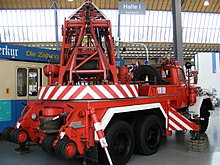Fire engine
|
Fire engine |
|
|---|---|
| Vehicle data
|
|
| Abbreviation: | FwK |
| Country: | Austria Germany |
| Crew : | 0/1/2/ 3 |
A fire brigade crane (abbreviated VCs ) is for the needs of firefighters equipped mobile crane . In Germany these crane trucks should be available everywhere, nationwide if required within 15 minutes, but often only large communities can afford these expensive special vehicles. Similar crane vehicles also exist at the technical relief organization . In Austria, these vehicles are usually stationed at bases by the regional fire brigade associations . The respective stationing fire brigade is responsible for staffing and maintenance.
tasks
The tasks of the fire brigade crane are:
- supraregional technical assistance ,
- Support in rescuing people from exposed locations,
- Fire fighting support,
- municipal services and technical administrative assistance.
Call names in Germany
The vehicle reports to the BOS radio with the radio call name: Florian. ./71 / .., provided that the respective federal state has introduced the “nationwide radio call names” in BOS radio (4m band).
Release orders
The fire brigade crane is usually deployed in combination with the equipment train to B. to erect overturned trucks or wagons or to lift heavy obstacles. Usually there is also a crane escort vehicle that carries the necessary crew and additional lifting gear; not infrequently it is a rescue vehicle ; but it can also be that it is in an AB crane ( roll-off container crane).
technology
technical structure
Fire brigade cranes do not differ in structure from other large mobile cranes.
Fire brigade loading
The loading of a fire brigade crane hardly differs from that of a normal truck crane, but the equipment boxes on the vehicle are very extensively equipped to meet the needs of the fire brigade. Fire brigade cranes have both yellow and blue rotating beacons (special signal system). At the rear of the vehicle, the crane trucks are usually equipped with a recovery thread and a towing device. The fire brigade crane often has a rescue cage that can be hung in and with which greater heights and particularly depths can be reached than with an aerial rescue vehicle . Some more modern fire-fighting cranes can also use these rescue cages to make reversible pipes . There are also modern FWK with (reduced) lattice mast tops, in the top of which monitors are attached.
history
The company Magirus-Deutz from Ulm was one of the pioneers in the construction of fire fighting cranes. In 1954 the Magirus-Deutz Uranus was presented, on the basis of which a fire brigade crane truck with 15 tonnes load capacity was available from 1956 with KW 15. At that time, this model was unrivaled in the market, not only in terms of engine output of 250 hp, but also in terms of the crane's load capacity. The crane truck was later upgraded to a load capacity of 20 tons (first KW 16, then KW 20). It was a lattice mast crane, the technology of the telescopic arm had not yet been developed. The Magirus-Deutz KW was the first fire-fighting crane truck to be purchased nationwide and built in large numbers in Germany. Later on, Faun and Liebherr cranes were very successful.
Alternatives
There are also sporadic rescue vehicles , equipment vehicles or swap bodies with cranes. However, these vehicles are not as powerful as specialized fire service cranes. Some fire brigades do without their own crane vehicles and cooperate with private companies that keep mobile cranes ready for fire brigade operations. The deployment costs are reimbursed by the fire service provider, who does not bear any acquisition or maintenance costs. This cost saving can justify the disadvantages of the longer alerting time and, due to the lack of right of way, longer travel times.
See also
literature
- Hamilton, Handbook for the Firefighter , Boorberg-Verlag, ISBN 3-415-01705-2
- Ulrich Cimolino et al. a: Use of crane trucks / rescue companies in: Einsatzpraxis, technical assistance in truck accidents , pp. 199–204, Verlag ecomed-Sicherheit, ISBN 3-609-68661-8
- Wolfgang Jendsch, Klagenfurt professional fire brigade: new Tadano Faun recovery and crane vehicle in: BRANDSchutz / Deutsche Feuerwehr-Zeitung , issue 6/2002, pp. 573-575
- For fire brigades and salvage (Tadano Faun BKF 40-4 L / Tadano Faun ATF 60-4) fire brigade crane with 45 t load capacity (Liebherr LTM 1045/1) In: KRANMAGAZIN , issue 31, 9/2003, pp. 14-16
- Gert Berg: Tadano Faun crane vehicle BKF 40-4 at the Wuppertal fire brigade . In: BRANDSchutz / Deutsche Feuerwehr-Zeitung , issue 9/2003, pp. 730/731
- Liebherr LTM 1060/2 as fire brigade crane FwK 40 in: Deutsche FEUERWEHRFAHRZEUGE , issue 1/2006, section 6 special vehicles, pp. 1–8
- Cimolino, Ulrich; Zawadke, Thomas: Emergency vehicles for fire and rescue services: types , ecomed, Landsberg, 2006
- German Fire Brigade Association: Fire Brigade Crane Specifications , 2004; http://www.dfv.org/fachthemen/fa3/Fachempfänger_Pflichtenheft_Kranwagen.pdf
Individual evidence
- ↑ Crane base Wels as an example of the Upper Austrian bases, accessed on July 11, 2016
- ↑ For example www.bos-fahrzeuge.de
- ↑ Crane company instead of fire brigade crane . In: Feuerwehr-Magazin , October 23, 2018. Retrieved November 4, 2018.


